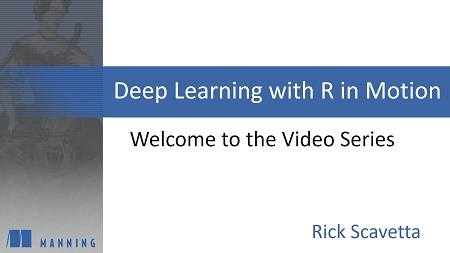
English | MP4 | AVC 1920×1080 | AAC 48KHz 2ch | 3h 52m | 3.71 GB
Deep Learning with R in Motion teaches you to apply deep learning to text and images using the powerful Keras library and its R language interface. This liveVideo course builds your understanding of deep learning up through intuitive explanations and fun, hands-on examples!
Machine learning has made remarkable progress in recent years. Deep learning systems have revolutionized image recognition, natural-language processing, and other applications for identifying complex patterns in data. The Keras library provides data scientists and developers working in R a state-of-the-art toolset for tackling deep learning tasks!
See it. Do it. Learn it! The keras package for R brings the power of deep learning to R users. Deep Learning with R in Motion locks in the essentials of deep learning and teaches you the techniques you’ll need to start building and using your own neural networks for text and image processing.
Instructor Rick Scavetta takes you through a hands-on ride through the powerful Keras package, a TensorFlow API. You’ll start by digging into case studies for how and where to use deep learning. Then, you’ll master the essential components of a deep learning neural network as you work hands-on through your first examples. You’ll continue by exploring dense and recurrent neural networks, convolutional and generative networks, and how they all work together.
And that’s just the beginning! You’ll go steadily deeper, making your network more robust and efficient. As your work through each module, you’ll train your network and pick up the best practices used by experts like expert instructor Rick Scavetta, Keras library creator and author of Deep Learning in Python François Chollet, and JJ Allaire, founder of RStudio, creator of the R bindings for Keras, and coauthor of Deep Learning in R! You’ll beef up your skills as you practice with R-based applications in computer vision, natural-language processing, and generative models, ready for the real-world.
What you will learn
- The 4 steps of Deep Learning
- Using R with Keras and TensorFlow
- Working with the Universal Workflow
- Computer vision with R
- Recurrent neural networks
- Everyday best practices
- Generative deep learning
Table of Contents
01 Welcome to the Video Series
02 What is Deep Learning
03 The Landscape of Deep Learning
04 The Landscape of Machine Learning
05 The Two Golden Hypotheses
06 The 4 Types of Machine Learning
07 Unit Introduction
08 The MNIST dataset
09 A first look at a neural network
10 The 4 steps of Deep Learning, part 1
11 The 4 steps of Deep Learning, part 2
12 The Uses of Derivatives
13 From Derivatives to Gradients
14 Momentum in Mini-batch Stochastic Gradient Descent
15 The 4 steps of Deep Learning, part 3
16 Basic Model Evaluation
17 Unit Introduction
18 The story so far
19 The Reuters Newswire dataset – data preparation
20 The Reuters Newswire dataset – model definition and evaluation
21 The Reuters Newswire dataset – reanalysis
22 The IMDB Dataset – Data preparation, model definition, and evaluation
23 The IMDB Dataset – reanalysis
24 The Boston Housing Dataset – data preparation and model definition
25 The Boston Housing Dataset – K-fold cross validation and evaluation
26 Summary of the case studies
27 Review of the landscape
28 Validation – 3 varieties
29 Model Evaluation
30 Data Pre-processing
31 The machine learning universal workflow and Part 1 wrap-up
32 Unit Intro
33 Intro to Computer Vision
34 Convnets on MNIST
35 Convnets 1 – Define Convnets from Scratch
36 Convnets 1 – Import, Compile, and Train
37 Convnets 2 – Data Augmentation
38 Convnets 3 – Pre-Trained Intro
39 Convnets 3 – Pre-Trained Code
40 Introduction to Text and Sequences
41 Word Embeddings from Scratch
42 Pre-Trained Word Embeddings
43 RNNs on the IMDb Dataset
44 LSTMs on the IMDb Dataset
45 Chapter Intro
46 Idiosyncratic Structures
47 Callbacks and TensorBoard
48 A Review of Best Practices
Resolve the captcha to access the links!